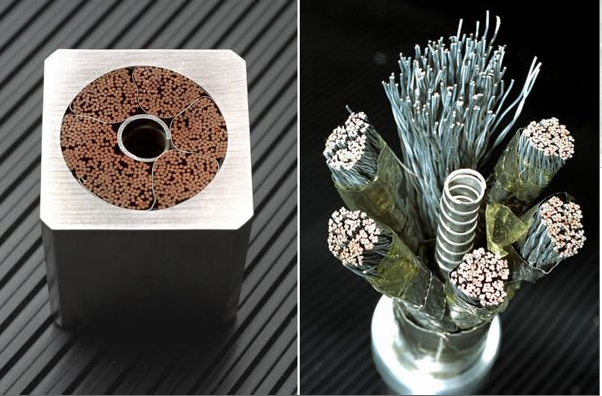In Saturday's 14th Dec 2013 press release, the University of Twente announced that a new finding in cable technology for superconducting magnets coils in tokamaks makes the magnets more robust, and strongly reduces the internal heating of the coils. This breakthrough in the superconducting magnet coil technology was developed at the EMS group of the University of Twente, one of the FuseNet members.
"The worldwide development of fusion reactors is up and running, and this breakthrough leads to a new impulse. The new cables are already extensively tested in two institutes" said research/project leader Arend Nijhuis on the website of the university (see link). Meanwhile, Nijhuis is invited for a new collaboration with China and expects that the "Twente method" will become a world-standard.
The challenge of superconducting magnets
A fusion plasma in a tokamak is confined by a strong magnetic field, which is achieved by superconducting magnet coils. To reach superconductivity, the cables inside the magnet are cooled by liquid helium to a temperature of about 4.5 K (-269 oC), which reduceses the electrical resistance.
In ITER, a magnetic field of ~13 T is generated by a current as high as 45.000 Amperes that runs through these coils. This puts an extreme pressure on the cables. In addition, fast fluctuations in the magnetfic field can heat up the wires to levels at which the superconductivity ceases, and hence the plasma can no longer be confined. These two issues are tackled by weaving the superconducting wires in a special way.

Superconducting cables: (left) cross-section of a field coil, (right) the cable comprises many individual wires
Smart wire-weaving increases resistance against mechanical forces and reduces the currents between wires
The cables of the 13 m high magnet coils consist of weaved wires with an diameter of 0.8 mm. The wiring occurs in different levels. In the first level, three thin wires are bundled; two are made from superconducting niobium-tin, and the other from copper. The copper is installed to resist the heating in case the superconducitvity ceases. In the next level, three of those first-stage wires are twisted around eachother. This weaving process continues in the same fashion in the next levels, until the right thickness is achieved.
The number of twists per length unit, and the proportions of this number between the different weave levels, turned out to be crucial. A higher number of twists per length makes the cable more resistant against mechanical forces in the coil, and prevents deformation. The breakthough is the newly found - but predicted - "number of twists per length proportion" that reduces the currents between the wires, which lowers the heating of the coil; hence, the superconductivity state in the wire remains at higher electric currents. This is important for the success of future fusion power plants.
Read more:
- University of Twente (Dutch): Doorbraak Brengt Kernfusie-Energiecentrale Dichterbij
- Volkrant (Dutch): Nederlandse doorbraak kernfusie
